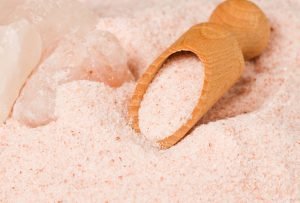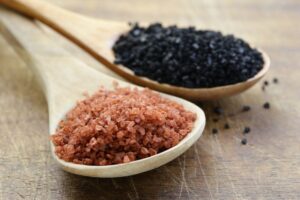What's On This Page?
ToggleBefore you reach for that salt shaker, you need to know that the kind that you eat matters.
The typical table salt found in almost all kitchens and restaurants is similar to the industrial chemical used to de-ice highways. Now that doesn’t sound very appetizing, does it?
Despite its bad rap as a prime driver of heart disease, good salt is actually an essential component of a healthy diet. Even the mainstream medical establishment is starting to understand that good salt isn’t the bad guy it’s been made out be. In 2011, a study published in The Journal of the American Medical Association (JAMA) found that the risk of heart disease and related deaths rises with modest reductions. (Yes, it rises!)
This is troubling when you consider that the U.S. Dietary Guidelines have been steadily recommending that Americans reduce their sodium intake, from 6000 mg per day in the 2005 guidelines to 2300 mg per day in the 2015 guidelines.
Another 2010 study, published by researchers out of Harvard, found a link between a low-salt diet and an increase in insulin resistance, which is the gateway problem that leads to diabetes and obesity. And the insulin resistance developed quickly—within one week of adopting the low-salt diet. Yikes!

The Kind of Salt Matters
Table salt is so refined that I consider it a food additive and not a food. It’s high in sodium and chloride only, it has been stripped of life-sustaining minerals like copper, iodine, potassium, magnesium, chromium, iron and zinc. Zinc is more important than you think, read my other article, 6 Critical Reasons You Need Zinc.
Anyway, it’s so refined, there is nothing left except sodium chloride. It’s nutritionally naked. As if that’s not bad enough, refined salt is then mixed with chemicals to keep it from clumping up inside the shaker.
One of the anti-caking agents used is talc, which is a known carcinogen (that’s why pediatricians have stopped recommending the use of talcum powder on babies). It’s also typically fortified with potassium iodide, which then requires chemical stabilizers to prevent breaking down and releasing an unpleasant odor. A common stabilizer used is dextrose, which is a sugar.
The Controversy for People with Blood Pressure Problems
The debate between sea salt and sodium chloride (table salt) concerning blood pressure is a topic that has garnered attention in both the scientific community and among health-conscious individuals. Sea salt is often marketed as a healthier alternative, primarily due to its trace minerals and less processed nature.
However, both contain roughly the same amount of sodium by weight, which is the primary factor affecting blood pressure. The crux of the controversy lies in whether the minimal processing and trace minerals found in sea salt offer any significant health benefits over the plain white kind!
Some argue that the trace minerals in sea salt can contribute to better health outcomes, while others point out that the high sodium content in both types can lead to hypertension if consumed in excess. This ongoing debate reflects a broader discussion on dietary sodium’s role in health and the importance of moderation, regardless of the salt type.
You may want to read my other article, How Hawthorn Lowers Blood Pressure.
Find out how Prunes Can Help Osteoporosis and Blood Pressure.
How Did Himalayan Benefit People with Hypothyroidism
Sea salt and Himalayan salt, often praised for their mineral content, can offer some benefits for individuals with hypothyroidism, a condition characterized by an underactive thyroid gland. These types are less processed than table salt and contain a variety of minerals, including iodine, magnesium, calcium, and potassium, though in varying amounts.
The presence of these minerals, especially iodine, is particularly beneficial for thyroid health, as iodine plays a crucial role in the production of thyroid hormones. Thyroid hormones are essential for regulating metabolism, energy levels, and overall bodily functions.
However, it’s important to note that while sea salt and Himalayan salt do contain trace amounts of iodine, the concentration is often lower and less consistent than that found in iodized table salt. For people with hypothyroidism, especially those in iodine-deficient regions, iodized salt may still be a more reliable source to ensure adequate iodine intake, unless of course you want to supplement which would really give you a boost!
Additionally, the other trace minerals found in sea and Himalayan salts such as magnesium and calcium, can support overall health, which may indirectly benefit thyroid function. Magnesium, for example, is involved in hundreds of biochemical reactions in the body, including those that support energy production and enzyme function, areas that can be affected if you have hypothyroidism.
Moderation is key. It’s essential to maintain a balanced diet and follow medical advice, including appropriate supplementation based on individual needs. Consulting with a healthcare provider can help determine the best dietary approach for managing hypothyroidism and ensuring adequate mineral intake.
There are Health Benefits
Avoiding unrefined sea salt could actually be bad for your health.
Unrefined sea salt is not chemically modified in a lab or stripped of its minerals. Colorful, unrefined sea salt is essentially water from a sea or river that gets evaporated and purified. These types of salts should not dramatically impact blood pressure like table salt.
In fact, they offer healthy minerals which drive thousands of metabolic reactions in your body all day long. Purifed (but unrefined) sea salt fully retains healthy minerals that you need for your very survival, and for normal thyroid, muscle, heart and pancreatic function.
If you want to boost the health benefits, choose a colored sea salt because the colors come from specific minerals that have additional health benefits of their own.
Here are 5 of my favorites:
1. Pink Himalayan Salt
This pretty pink salt is mined from salt deposits located near the Himalayas. It gets its pink color from iron, but that’s not the only mineral this salt contains. Himalayan salt contains over 80 trace minerals —the most of any type of salt. Because it’s harvested from deposits that are underground, it is less exposed to the environmental toxins that are now found in our oceans and rivers. This is my go-to salt for everyday use—I feel like I’m taking a multi-mineral supplement each time I flavor my food with it.
2. Celtic or French Grey
This light grey salt comes from Brittany, in coastal France, and gets its color from the clay found in the tidal pools where the salt is dried. It does not have quite as many different minerals in it as pink Himalayan salt, but it has the highest content of minerals, gram for gram, of any salt, and is a particularly good source of magnesium.
Grey sea salt has the highest moisture content of any of the salts I’m covering in this article, so if you plan to put it in a salt grinder, you may want to get a ceramic grinder to prevent it from sticking to the gears. The coarse granules are great sprinkled over the top of a salad, a bowl of chili, or even on chocolate mousse or caramel gelato.

3. Red Alaea Hawaiian Salt
This sea salt starts white but then develops a beautiful rich red color when it’s dried in salt ponds that are lined with red volcanic clay (known as alaea in Hawaiian). That red hue comes from the presence of iron oxide, a digestible form of iron naturally found in the clay. This type contains as many as 80 other trace minerals. Taste-wise, I’d say it has a mellow, earthy flavor, making it a great way to add a savory taste to your food.
4. Cyprus or Hawaiian Black Lava Salt
This kind is naturally occurring sea salt is mixed with activated charcoal to give it its distinctive black color. It has a lower sodium content per gram than Himalayan, which means you can use more of it without getting an overly salty taste. Don’t let the thought of eating charcoal scare you—we’re not talking about the charcoal briquettes that you’d use to fuel your grill!
This activated charcoal is made from wood, coal, or coconut shells which are burned to create a surface with lots of tiny little nooks and crannies. It’s referred to as either Cyprus or “Hawaiian” but regardless, the salt is black in color.
Once prepared, the activated charcoal has a positive charge that attracts negatively-charged ions (such as free radicals), which then lodge themselves in all the microscopic openings. Activated charcoal is like a sponge for toxins that then carries them out of your body through the digestive tract.
There are supplements of this that are sometimes used in poisonings or removal of gut toxins. While the small amount of activated charcoal you’d ingest from sprinkling black lava salt on your food won’t be able to absorb a large amount of toxins, it still provides a little bit of natural detoxification support.
5. Kala Lamak
There’s another salt that is often used to cook Indian cuisine. If you love Indian food like I do, you’ve certainly tasted this salt, called kala namak. It’s also found in foods from Nepal, Bangladesh and Pakistan and it’s known as a “black salt.” Some dishes where kala lamak may be utilized is Chaat (a broad food category often seasoned with it), raita, vegan egg dishes and lassi.
Think of kala namak as more of a condiment. It has the same sodium chloride backbone as all salt, but it’s mixed with other herbs and smells a bit like very mild sulfur, which is due to the hydrogen and iron sulfide that it contains. It’s a delicious combination of spices, and I’m mentioning it here because it is also very dark in color, but it is not the same as Cyprus Lava salt, and it does not contain activated charcoal.
Summary
Unrefined are available from many retailers, such as your local health or gourmet food store. Many large grocery chains now carry them as well. If you prefer to shop online here’s an option for four of the delicious salts listed above. Other salt companies that I like include Selina Naturally Salt and REAL SALT.
While you’re shopping, take a look at this very cool bamboo salt (or spice) box, it’s 3-tiered and I keep this on my coffee table with various salts and spices. I got it as a gift from a dear friend and I can’t help but share it with you all.

Suzy Cohen, has been a licensed pharmacist for over 30 years and believes the best approach to chronic illness is a combination of natural medicine and conventional. She founded her own dietary supplement company specializing in custom-formulas, some of which have patents. With a special focus on functional medicine, thyroid health and drug nutrient depletion, Suzy is the author of several related books including Thyroid Healthy, Drug Muggers, Diabetes Without Drugs, and a nationally syndicated column.
